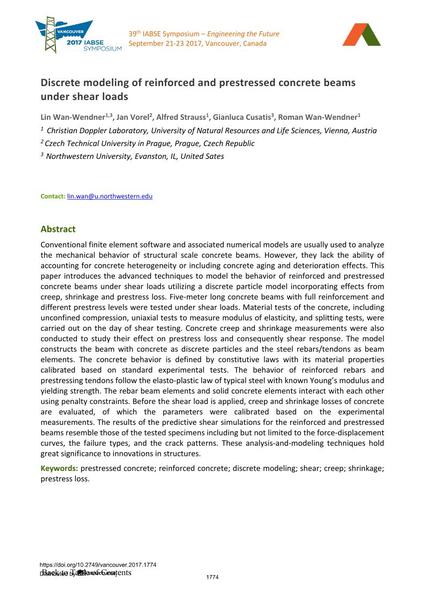Discrete modeling of reinforced and prestressed concrete beams under shear loads

|
|
|||||||||||
Détails bibliographiques
| Auteur(s): |
Lin Wan-Wendner
(Christian Doppler Laboratory, University of Natural Resources and Life Sciences, Vienna, Austria; Northwestern University, Evanston, IL, United Sates)
Jan Vorel (Czech Technical University in Prague, Prague, Czech Republic) Alfred Strauss Gianluca Cusatis Roman Wan-Wendner (Christian Doppler Laboratory, University of Natural Resources and Life Sciences, Vienna, Austria) |
||||
|---|---|---|---|---|---|
| Médium: | papier de conférence | ||||
| Langue(s): | anglais | ||||
| Conférence: | IABSE Symposium: Engineering the Future, Vancouver, Canada, 21-23 September 2017 | ||||
| Publié dans: | IABSE Symposium Vancouver 2017 | ||||
|
|||||
| Page(s): | 1774-1781 | ||||
| Nombre total de pages (du PDF): | 8 | ||||
| Année: | 2017 | ||||
| DOI: | 10.2749/vancouver.2017.1774 | ||||
| Abstrait: |
Conventional finite element software and associated numerical models are usually used to analyze the mechanical behavior of structural scale concrete beams. However, they lack the ability of accounting for concrete heterogeneity or including concrete aging and deterioration effects. This paper introduces the advanced techniques to model the behavior of reinforced and prestressed concrete beams under shear loads utilizing a discrete particle model incorporating effects from creep, shrinkage and prestress loss. Five-meter long concrete beams with full reinforcement and different prestress levels were tested under shear loads. Material tests of the concrete, including unconfined compression, uniaxial tests to measure modulus of elasticity, and splitting tests, were carried out on the day of shear testing. Concrete creep and shrinkage measurements were also conducted to study their effect on prestress loss and consequently shear response. The model constructs the beam with concrete as discrete particles and the steel rebars/tendons as beam elements. The concrete behavior is defined by constitutive laws with its material properties calibrated based on standard experimental tests. The behavior of reinforced rebars and prestressing tendons follow the elasto-plastic law of typical steel with known Young’s modulus and yielding strength. The rebar beam elements and solid concrete elements interact with each other using penalty constraints. Before the shear load is applied, creep and shrinkage losses of concrete are evaluated, of which the parameters were calibrated based on the experimental measurements. The results of the predictive shear simulations for the reinforced and prestressed beams resemble those of the tested specimens including but not limited to the force-displacement curves, the failure types, and the crack patterns. These analysis-and-modeling techniques hold great significance to innovations in structures. |
||||
